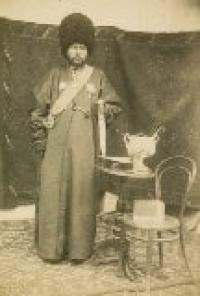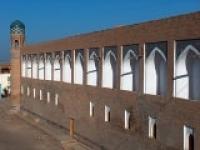Вы здесь
Muhammad Rakhim-khan Madrasah.


Individual tour to Khiva.
“The Shah having glory like heavens,
In his State his word has a sharpness and power.
When his steps reached the throne of the State,
from his blessed steps Khorezm turned into a paradise.
This building is the abode of the goodness,
Erected by his generosity for the scholars with high knowledge”
Poet Kamil (Khorezmi).
Romantic getaway in Khiva.
The madrassah located opposite to the gates of Kunya-Arch was built under the decree of Seyyid Muhammad Rahimkhan II in 1871. For its large scales and majesty it is distinguished from other madrassahs of Khiva.
Single-storey cells built even long before the construction of the madrassah form a small courtyard before the main facade of the madrassah. From the side the square shopping arcades with high aivans adjoin to the hujras.
The madrassah is high on the list in Khiva by the size of its area. In the madrassah there are premises of a summer and winter mosques, an audience (darskhana), as well as a library and residential hujras for students and teachers.
The general architectural construction of the madrassah is slightly different from the generally accepted norms. Some supernatural kind of view expressed in large volumes of the building is felt.
The yard of madrassah is surrounded by 76 single-storey cells designed for 152 students. From the outside the roof of hujras are limited by an obstacle in the form of a low wall (parapet) adjacent to the central two-story front facade of the madrassah.
On both sides of a slender portal the five-arch gallery is located. The lobby group consists of eight calottes which is the largest number in a Central Asian madrassah. The patterned ornaments laid out from glazed bricks on the front walls repeat conventional forms.
The structure of the court leaves a different impression with the visitor. A row of one-story courtyard hujras, high decorative portals and external blank wall together with beautiful turrets-guldasta on angles are a remarkable pattern.
By the Khan for the madrassah (source of income, providing activities of the madrassah) 2941 Tanap of land (2.5 Tanap - 1 hectare) was allocated as Waqf. In celebrations of opening of the madrassah decorated with exquisite majolica tiles, poets and scholars of that time who wrote laudatory chronograms and sang in their qasidas (odes) the power and generosity of the Khan were generously rewarded by the Khan.
In addition expenditures on gifts to the courtiers, relatives, artisans and craftsmen who worked on the construction by the Khan himself personally 118 Tillia (gold coins) was handed out on this feast.
On the portal of the madrassah in Arabic the following words are written which give in translation this content: “This blessed building has been erected on the behest of the Sultan of his time and Khaqan of the world, and the Caliph and a shadow Allah, the master of victories and glory, the lord of invincible power conquering the countries Seyid Mohammad Rakhim Bahadurkhana date 1289 hijra (1872)”.
Above the door on a marble slab carved by master - engraver on marble, Pakhlavan Niyaz Khorezmi a chronogram in the form of poetry written in Farsi of a famous poet Kamil (Khorezmi).
On the four portals of the courtyard of the madrassah two chronograms are written in verses composed by Mohammed Riza Aghehi and Kamil Khorezmi, poets of Khiva. They glorified the Khan thanks to and by the grace of whom the country became well maintained, his justice of spread throughout the world, that scientists obtained degrees and achieved their goals, the Khan himself, rendering care for scientists and enlightened (people), was awarded the title of the patron of knowledge and science.
In the very early years of our Independence, namely in 1994, the madrassah was restored and as a jubilee gift for the celebration of 150th birthday anniversary of Muhammad Rahimkhan "Feruz" of the Shah and the poet which was conducted in September the same year, museum exposition of the History and Literature of Khorezm was established and opened in the madrassah.
The museum exposition has taken quite a large space including the lobby, the audience and winter mosque of the madrassah. At the entrance of the museum in front of our sights there appears the history, culture and arts of the peoples who lived in the territory of the Khanate of Khiva founded at the beginning of the XVI century and its neighboring States of Iran and Bukhara Emirate.
Here we can learn the materials about the formation of the centralized state in the late XVI and early XVII centuries in Khorezm, as well as the ntral Asian States and in particular the Khanate of Khiva in 1873.
Unique monuments of our region, stimpact of its internal and foreign policies on the nations of Central Asia. Exposition of the department reflects materials depicting the second half of the XIX century and how the Imperial Russia aiming at satisfactions of its needs in industrial raw materials had taken "A campaign to the East" and conquered the Ceate and national wealth and valuables were taken away and in order to fill their loss among the first in Central Asia.
On the initiative of Muhammad Rahimkhan II there was organized and gained a mass dissemination the products (books) of the First in Central Asia lithography, the legacy left by the pioneer of the Uzbek photo and cinema arts Khudaibergen Divanov, the items displaying work of "tanbur notation" which shows how ancient musical melodies - maqom shifted to notes by the famous poet and the musician Kamil Khorezmi.
Text and photographs narrating about great thinkers, poets and personalities who gained respect of the nation, such as: Pakhlavan Makhmud, Abulghazi Bahadurkhan Muhammad Rakhimkhan Feruz, Munis and Aghehi.
The museum presents for display the state symbols of Khiva Khanate - the banners, money, trade items imported from foreign countries, Chinese and Russian porcelain, products of local artisans, weapons, clothing, household utensils and other exhibits and the last authentic photographs of representatives of Khans of Khiva.
The overall dimensions of the madrassah is 62 x 50 meters 28 x 29 meters courtyard, patio in front of the madrasah is 20 x 42 meters.
Authority:
http://welcomeuzbekistan.uz







